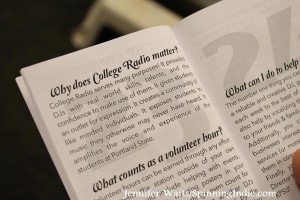An article on PolicyMic, 4 Awesome College Stations Keeping Radio Alive, posits that college radio was in a downward spiral and is now in a period of renaissance. After author Chelsea Hawkins takes a look at some recent CMJ-award-winning college radio stations, she surmises,
“Two years ago, it looked like student radio was heaving its last breath. But one look at the communities surrounding WSOU, KUOM, WBDM and WTBU and you’ll begin to wonder: is student-initiated media making a comeback? While it’s hard to say for sure, I know that in a world full of nonsense and noise, having a station that represents my community feels indispensable.”
I’m the first to admit that the high profile shut-downs of several college radio stations in 2011 was alarming and that it prompted many of us to talk about the importance of saving college radio. Specifically, University of San Francisco station KUSF was taken off FM and its license was ultimately sold to Classical Public Radio Network after a drawn-out legal fight. Students have resumed online broadcasts of KUSF.org and former KUSF DJs broadcast online at KUSF-in-Exile. Rice University station KTRU was taken off FM and the license was sold to University of Houston (although KTRU lives on over HD-2 and online). Vanderbilt University station WRVU also left FM (but continues operating online and over HD-3) when its owner opted to lease its signal to Nashville Public Radio. Still owned by Vanderbilt Student Media, the frequency sale is awaiting approval by the FCC.
At KUSF, WRVU, and KTRU (as well as at several other stations), students were no longer given the opportunity to broadcast over FM, although in each instance, student radio continued on campus in another form. Although FM was taken away, it didn’t necessarily mean that radio was killed off on campus.
Likewise, the events of 2011, did not indicate to me that college radio was dying. In fact, in my year-end wrap up post for 2011, I argued that 2011 was the year that college radio fought back. I was inspired by the passion for college radio that prompted widespread protests about recent station losses. Additionally, apart from these gloom and doom stories about college radio stations in crisis, throughout the past two years there have also been numerous examples of thriving college radio stations as well as examples of brand new stations cropping up. With the current LPFM licensing window open for business (until November 14), many college radio stations are optimistic about the possibility of obtaining a terrestrial radio license in the not-to-distant future. Stations like KPSU at Portland State University have had a taste of terrestrial radio before and are dreaming of being back on the airwaves.
Certainly there will still be challenges for college radio, as there have been since its earliest days. Since 2011, more stations have left the airwaves and there will be others. Although I am a big proponent of terrestrial radio, I know that stations can thrive in other forms and I’m convinced that college radio will persevere, perhaps in a form that we have yet to invent or imagine.
What do you think? Is student media making a comeback or has it been thriving all along?



